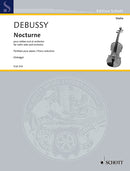| 作曲者 | Claude Debussy & Robert Orledge |
| タイトル | Nocturne pour violon et orchestre |
| サブタイトル | completed and orchestrated after the sketches of Debussy by Robert Orledge |
| 出版社 | Schott・ショット |
| シリーズ名 | Violin Library |
| 楽器編成 | violin and orchestra |
| 楽器編成(詳細) | 3 (3. auch Picc.) · 2 (2. auch Engl. Hr.) · 2 · 2 - 2 · 1 ·2 · 1 - 3 P. S. (Trgl. · hg. Beck. · Tamb.) (1 Spieler) - Hfe. · Cel. - Str. (10 · 8 · 6 · 6 · 4) |
| 品番 | 9790001164375 |
| 校訂者 | Robert Orledge |
| 形状 | 36 ページ・Saddle stitching |
| 演奏時間 | 10分 |
| 作曲年 | 1893-1896/2016年 |
| 出版年 | 2017年 |
| 出版番号 | VLB 214 |
| ISMN | 9790001164375 |
The Belgian violinist, Eugène Ysaÿe (1858-1931), with his impressive blend of virtuosity and poetry, was a great admirer of the young Debussy’s music who led the Paris première of his only string quartet in December 1893. In September 1892, Debussy was planning an American tour with the financial support of Prince André Poniatowski that was to include his ‘nearly completed three Scènes au crépuscule’, inspired by the Symbolist poetry of his friend Henri de Régnier. He made ‘extensive revisions’ to them in 1893, even if all that seems to have survived is a series of sketches in Bibliothèque Nationale de France, MS 20632(2), most of which appear to be for violin and orchestra in E or B major. Another related, and more virtuosic, theme emerged in a Parisian sale in June 2006, which opens the main part of the present Nocturne (after a slow introduction).We also learn from Ernest Chausson in April 1893 that Debussy was composing a work for Ysaÿe’s first American tour in 1894-95, which at one stage was described as a ‘concerto’. Then, as Debussy was putting the finishing touches to L’Après-midi d’un faune in 1894, he told Ysaÿe he was now working on ‘three Nocturnes for solo violin and orchestra which are destined for you’, and which undoubtedly derived from his earlier ‘Twilight scenes’. The first was to be ‘for strings only’; the second for three flutes, four horns, three trumpets and two harps; the third combines all these instruments’. He also informed Ysaÿe, perhaps with Whistler’s Nocturnes in mind, that they were to be like ‘a study in grey in painting’. Debussy only abandoned this project in November 1896 after Ysaÿe told him he would not be able to première the Nocturnes in Brussels ‘for financial reasons’.My completion comes closest to the third Nocturne Debussy planned and to being a rondo with related episodes. The dynamic idea that emerged in 2006, which was scored by Debussy, leads naturally into the ‘twilight’ theme in B major beginning on solo cello and doublebasses, with the high, haunting three-note idea first heard at the outset floating above on solo violin, exactly as Debussy conceived it. All five of Debussy’s themes are harmonized and they vary in length between three and thirteen bars: none of them relate to the orchestral Nocturnes of 1897-99. Rather than develop any of these themes, they are presented in changing harmonic backgrounds in the contemporary manner of L’Après-midi d’un faune, and the whole work centres on an expansive scalar which joins the various aspects of Debussy’s ‘twilight’ themes together in a new perspective.



